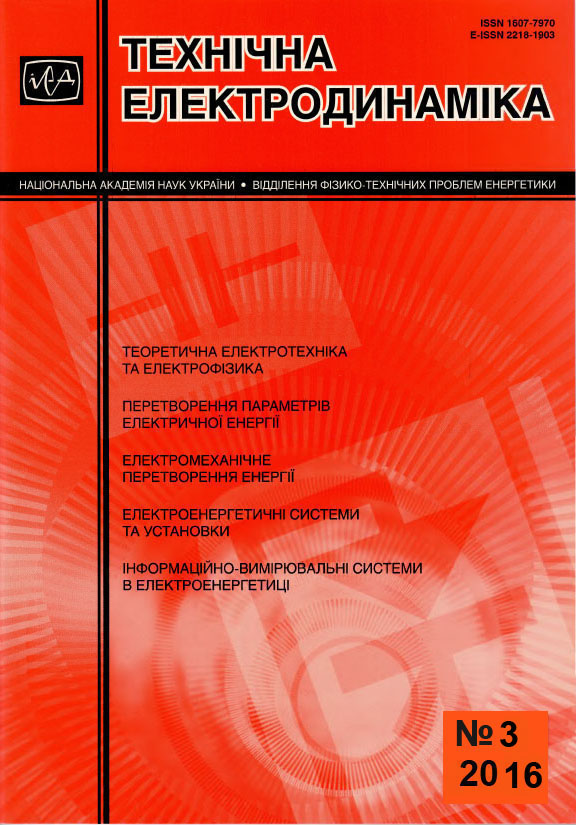Abstract
This paper deals with a brief description and the basic equations of the Jiles-Atherton theory of ferromagnetic hysteresis, and information about its application in world practice to construct a mathematical model of the current transformer, calculations and research of electromagnetic processes in these devices. Improving of mathematical model of current transformer based on the Jiles-Atherton theory have been proposed and justified, by the way of describing it anhysteretic magnetization curve by second order fractional rational function instead modified Langevin function. According to the developed model of current transformer, transient currents of TFKN-330 type of current transformer with different steel grades of magnetic cores and with different ways of describing its anhysteretic magnetization curve have been calculated and their comparative analysis have been made. Briefly examined the possibility of using optimization genetic algorithm of differential evolution to determine the parameters of proposed model. References 11, figures 3.
References
Annakkage U.D., McLaren P.G., Jayasinghe R.P., Parker A.D. A current transformer model based on the Jiles-Atherton theory of ferromagnetic hysteresis // IEEE Transaction on power delivery. – 2000. – Vol. 15. – No 1. – Pр. 57-61.
Benabou A., Clenet S., Piriou F. Comparison of Preisach and Jiles-Atherton models to take into account hysteresis phenomenon for finite element analysis // Journal of magnetism and magnetic materials (Elsevier). – 2003. – Vol. 261. – No 1–2. – Pp. 139-160.
Chwastek K., Szczyglowski J. Identificationof a hysteresis model parameters with genetic algorithms // Mathematics and Computers in Simulation. – 2006. – Vol. 71. – Pp. 206-211.
Jiles D.C., Atherton D.L. Theory of ferromagnetic hysteresis // Journal of magnetism and magnetic materials. – 1986. – Vol. 61. – Pp. 48-60.
Jiles D.C., Thoelke J.B. Theory of ferromagnetic hysteresis: determination of model parameters from experimental hysteresis loops // IEEE Transactions on magnetics. – 1989. – Vol. 25. – No 5. – Pp. 3928-3930.
Kis P. Jiles-Atherton model implementation to edge finite element method, thesis to the Ph.D Dissertation, Dept. of Broadbant Infocommunications and Electromagnetic Theory, Budapest University of Technology and Economics, Budapest, 2006, – 143 p.
Liu S.-T., Huang S.-R., Chen H.-W. Using TACS functions within EMTP to set up current-transformer model based on the Jiles-Atherton theory of ferromagnetic hysteresis // IEEE Transaction on power delivery. – 2007. – Vol. 22. – No 4. – Pp. 2222-2227.
Naghizadeh R.-A., Vahidi B., Hosseinian S.H. Parameter identification of Jiles-Atherton model using SFLA // Computation and mathematics in electrical and electronic engineering. – 2012. – Vol. 31. – No 4. – Pp. 1293-1309.
Qin A.K., Huang V.L., Sugunthan P.N. Differential evolution algorithm with strategy adaptation for global numerical optimization // IEEE Transactions on evolutionary computation. – 2009. – Vol. 13. – No 2. – Pp. 398-417.
Tziouvaras D.A., McLaren P., Alexander G., at. al. Mathematical models for current, voltage and coulping capacitor voltage transformers // IEEE Transaction on power delivery. – 2000. – Vol. 15. – No 1. – Pp. 62-72.
Vesterstrom J., Thomsen R. A comparative study of differential evolution, particle swarm optimization, and evolutionary algoritms on numerical benchmark problems // CEC2004. Conference on Evolutionary computation (June 19-23, 2004); IEEE, 2004. – Pp. 1980-1987.

This work is licensed under a Creative Commons Attribution-NonCommercial-NoDerivatives 4.0 International License.
Copyright (c) 2022 Tekhnichna Elektrodynamika

